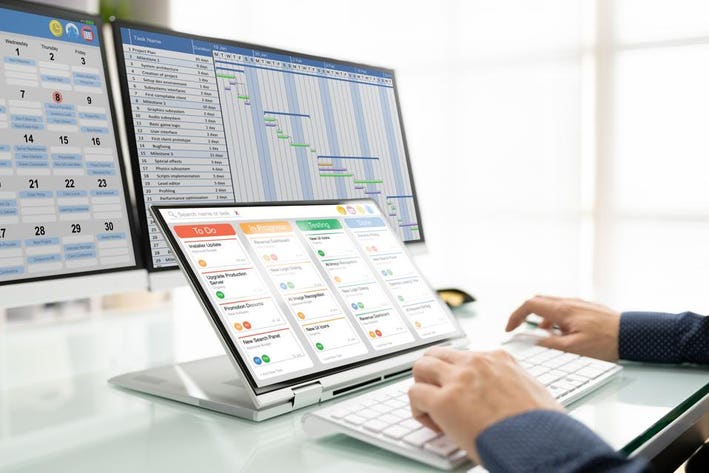1. Integration with IoT and Smart Devices
In Industry 4.0, Kanban boards are increasingly integrated with Internet of Things (IoT) devices and smart sensors. This allows real-time data collection and monitoring directly from the production floor. For example, sensors on machines can provide data about equipment status and production metrics, which can be reflected on digital Kanban boards. This integration enhances visibility and responsiveness, helping teams make informed decisions based on up-to-date information.

2. Real-Time Analytics and Data Visualization
Industry 4.0 emphasizes the use of big data and advanced analytics. Digital Kanban boards leverage these technologies to provide real-time analytics and visualizations. This enables teams to track key performance indicators (KPIs), identify trends, and predict potential issues. Enhanced data visualization tools can help in monitoring progress, performance, and bottlenecks more effectively.
3. Cloud-Based Kanban Solutions
The shift towards cloud computing in Industry 4.0 has led to the adoption of cloud-based Kanban solutions. These platforms offer accessibility from any location, facilitating remote collaboration and real-time updates. Cloud-based Kanban boards also integrate with other digital tools and systems, such as ERP (Enterprise Resource Planning) and CRM (Customer Relationship Management) systems, providing a comprehensive view of operations.
4. Automation and AI Integration
Automation and artificial intelligence (AI) play a crucial role in Industry 4.0. Kanban boards in this context can be integrated with AI-driven systems to automate repetitive tasks, such as updating card statuses or assigning tasks. AI can also help in predicting and managing workloads based on historical data and current trends, optimizing resource allocation and improving overall efficiency.
5. Enhanced Collaboration Tools
Digital Kanban boards in Industry 4.0 often include advanced collaboration features, such as video conferencing, chat, and file sharing. These tools facilitate better communication among team members, regardless of their physical location. Enhanced collaboration supports agile project management and helps teams respond quickly to changes and challenges.
Kanban Boards in Industry 5.0: Embracing Human-Centric and Sustainable Practices
1. Human-Centric Design and Collaboration
Industry 5.0 focuses on integrating human-centric approaches with advanced technologies. Kanban boards in this era are designed to enhance human interaction and collaboration. Features such as intuitive interfaces, customizable workflows, and user-friendly dashboards are prioritized to ensure that the technology complements human skills and decision-making. This approach promotes a balanced and effective work environment.
2. Sustainability and Green Manufacturing
As Industry 5.0 places a strong emphasis on sustainability, Kanban boards are increasingly used to support green manufacturing practices. This includes tracking and managing waste reduction efforts, monitoring energy consumption, and ensuring compliance with environmental regulations. Kanban boards can help visualize and manage sustainability initiatives, promoting more eco-friendly and efficient operations.
3. Personalization and Employee Well-Being
In Industry 5.0, Kanban boards are designed to enhance employee well-being and job satisfaction. Personalized Kanban boards can cater to individual work preferences and needs, offering features that support work-life balance and mental health. This includes customizable workflows, flexible task management options, and tools that promote a positive and supportive work environment.
4. Advanced Integration with Robotics and Cobots
Industry 5.0 integrates advanced robotics and collaborative robots (cobots) into the manufacturing process. Kanban boards in this context can be used to coordinate and manage the interaction between human workers and robots. This includes tracking robot performance, managing maintenance schedules, and ensuring seamless collaboration between human and robotic resources.
5. Continuous Improvement and Innovation
Kanban boards in Industry 5.0 emphasize continuous improvement and innovation. They are designed to support iterative processes and facilitate feedback loops. Features such as real-time updates, continuous learning modules, and innovation tracking tools help organizations adapt to changing conditions, embrace new technologies, and drive ongoing improvements.
Conclusion
Kanban boards have evolved significantly from their traditional use to become powerful tools in both Industry 4.0 and 5.0 contexts. In Industry 4.0, digital Kanban boards enhance efficiency through integration with IoT, real-time analytics, and automation. In Industry 5.0, they embrace human-centric and sustainable practices, supporting employee well-being and advanced technologies. By leveraging the strengths of Kanban boards in these evolving industries, organizations can drive productivity, innovation, and sustainability in their operations.